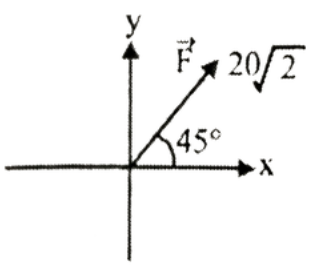A certain vector in the xy plane has an x-component of 12 m and a y-component of 8m. Its then rotated in the xy plane so that its x-component is halved. Then its new y-component is approximately :
14 m
13.11 m
10 m
2.0 m
The correct Answer is:B
To solve the problem step by step, we will follow these instructions:
Step 1: Identify the initial components of the vector
The initial vector has an x-component of 12 m and a y-component of 8 m. We can represent this vector as:
→R1=12^i+8^j
Step 2: Calculate the magnitude of the initial vector
The magnitude of the vector →R1 can be calculated using the Pythagorean theorem:
|→R1|=√(12)2+(8)2=√144+64=√208
Step 3: Determine the new x-component after rotation
After the vector is rotated, the x-component is halved. Therefore, the new x-component is:
x′=122=6 m
Step 4: Set up the new vector with the new x-component
The new vector after rotation can be represented as:
→R2=6^i+y^j
where y is the new y-component that we need to find.
Step 5: Calculate the magnitude of the new vector
The magnitude of the new vector →R2 must be equal to the magnitude of the initial vector →R1 since the length of the vector remains unchanged during rotation. Thus:
|→R2|=√(6)2+(y)2
Step 6: Set the magnitudes equal to each other
Since the magnitudes are equal, we can write:
√(6)2+(y)2=√208
Step 7: Square both sides to eliminate the square root
Squaring both sides gives:
(6)2+(y)2=208
36+y2=208
Step 8: Solve for y2
Rearranging the equation to solve for y2:
y2=208−36=172
Step 9: Calculate y
Taking the square root of both sides gives:
y=√172≈13.11 m
Conclusion
The new y-component of the vector after rotation is approximately:
y≈13.11 m
The initial vector has an x-component of 12 m and a y-component of 8 m. We can represent this vector as:
→R1=12^i+8^j
The magnitude of the vector →R1 can be calculated using the Pythagorean theorem:
|→R1|=√(12)2+(8)2=√144+64=√208
After the vector is rotated, the x-component is halved. Therefore, the new x-component is:
x′=122=6 m
The new vector after rotation can be represented as:
→R2=6^i+y^j
where y is the new y-component that we need to find.
The magnitude of the new vector →R2 must be equal to the magnitude of the initial vector →R1 since the length of the vector remains unchanged during rotation. Thus:
|→R2|=√(6)2+(y)2
Since the magnitudes are equal, we can write:
√(6)2+(y)2=√208
Squaring both sides gives:
(6)2+(y)2=208
36+y2=208
Rearranging the equation to solve for y2:
y2=208−36=172
Taking the square root of both sides gives:
y=√172≈13.11 m
The new y-component of the vector after rotation is approximately:
y≈13.11 m
Topper's Solved these Questions
Similar Questions
Knowledge Check
The maximum number of components into which a vector can be resolved in its own plane is
A2B3C4Dmore than 4
The x− component of a certain vector in x−y plane is 2 units and y− component is +2√3 units. What is the magnitude of the vector.
View SolutionA particle has a displacement of 8 m . If one of its rectangular components is 4 m what is the other rectangular component ?
View SolutionA vector lying in x-y plane has a magnitude 3, and makes an angle 30∘ with the x-axis. Find its components along the two axes.
View SolutionIn the hexaploid wheat, the haploid (n) and basic (x) numbers of chromosomes are
View SolutionA displacement vector, at an angle of 30∘ with y-axis has an x-component of 10 units. Then the magnitude of the vector is-
View SolutionThe π - bounded organometallic compound which has ethylene as one of its component is
View SolutionFor the given vector →A=3ˆi−4ˆj+10ˆk, the ratio of magnitude of its component on the x−y plane and the component on z−axis is
View Solution

